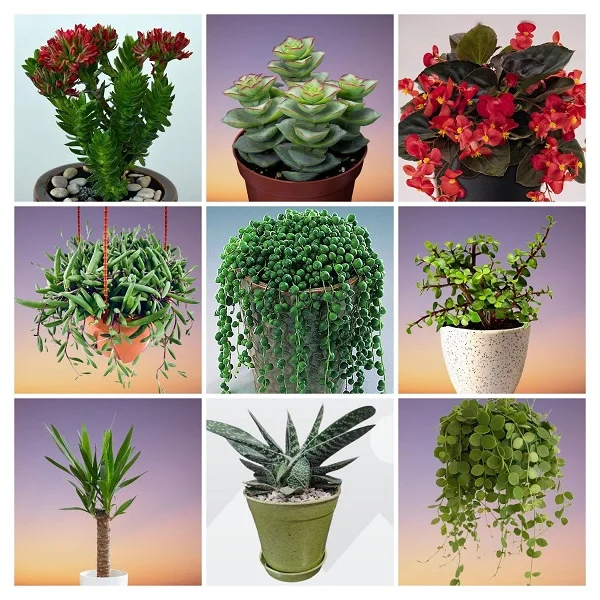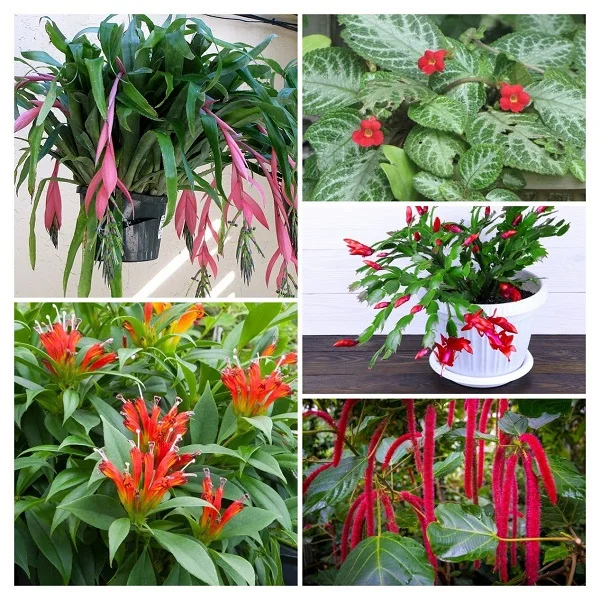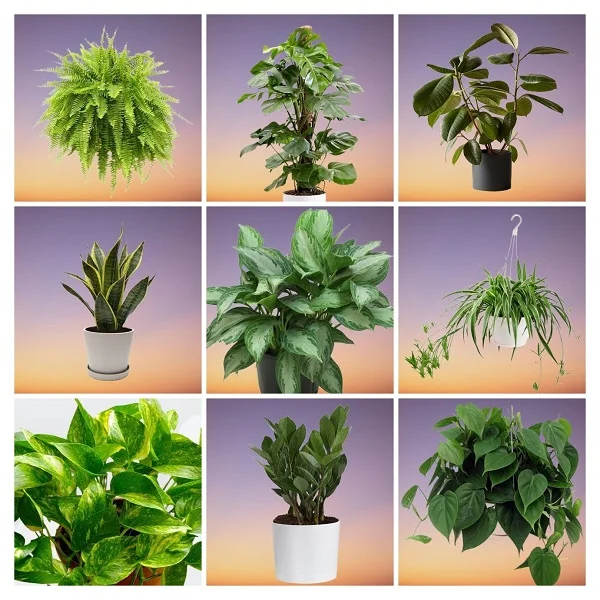Wax Begonia (Begonia semperflorens) Indoor Care, Propagation, Problems & Remedies
Some links in this post may be affiliate links
Wax Begonia (Begonia semperflorens) flourishes in bright indirect light with some sunshine, warm and humid conditions, and moderately moist, rich, well-drained soil coupled with fortnightly feeding in the growing season.
Begonia semperflorens is one of the popular Begonia varieties on account of its vibrant blooms, striking waxy foliage and ability to adapt to a wide range of growing conditions.
Begonia wax is one of the easiest to grow of the flowering Begonias. When given the right growing conditions it will continue to thrive and reward you with its beautiful blooms.
Wax Begonia is a small, leafy bush about 6-12 inches high which blooms almost the year round when grown in a sunny location. It is one of the best low-maintenance plants for a sunny balcony.
The Begonia Wax hybrids have a wide range of flower types in red, white, orange and pink. Newer hybrids are regularly developed which are more compact and have bigger blooms. These spectacular blooms place this plant among the best plants for the front porch or main entrance.
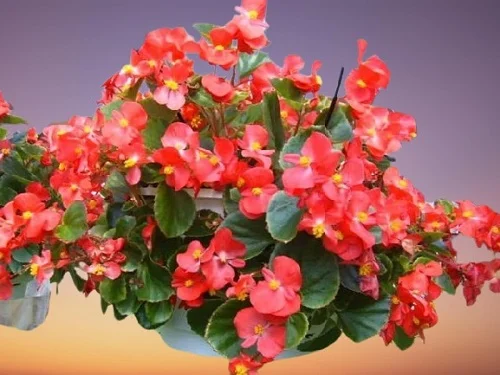
Botanical name: Begonia semperflorens
Family: Begoniaceae
Common name: Wax Begonia
Origin
In their natural habitat Begonias grow as understory plants in moist, shady to partially shady conditions in the tropical and subtropical regions in South and Central America, Africa and southern Asia.
Size
Wax Begonia grows to about 6-12 inches high. The hybrids have round waxy leaves about 2 inches across, ranging from greenish-yellow to deepest red. Begonia semperflorens like Begonia coccinea (Angel Wing Begonia) is one of the favorite flowering plants for the home.
Is Begonia Wax toxic?
Yes. All parts of Begonia semperflorens and especially the roots are considered toxic to pets as outlined by ASPCA. If ingested they may cause burning in the mouth and throat, vomiting, diarrhea and abdominal pains.
Where to Buy
If you would like to acquire Begonia Wax for your collection, they are readily available online on Etsy (Link to Etsy).
How to Care for Wax Begonia Indoors
Caring for Wax Begonia indoors, entails providing bright indirect light with 4-6 hours of sunshine, warmth of 18-270C, humidity of 60-70% and moderately moist, rich, well-drained soil coupled with fortnightly feeding during the growing season.
Begonia semperflorens care needs repotting only when extremely pot-bound as it grows best when slightly root-bound. Pruning is required to keep it neat, to reduce pest and disease infestations and to rejuvenate growth. Keep reading for a detailed account on the best growing conditions and how to provide them.
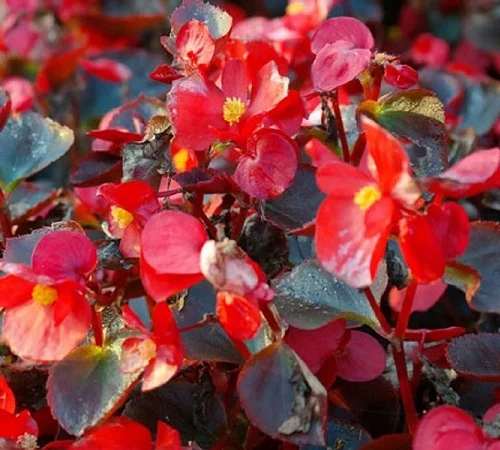
Water Requirements
How often should I water Wax Begonia?
Water Wax Begonia liberally in spring and summer while allowing the top 2-3 inches of soil to dry out slightly between waterings. Keep the soil moderately moist and avoid overwatering as it can result in rotting, yellowing, leaf loss and flowerbud drop.
Reduce watering in fall and winter to maintain the soil slightly moist as growth is minimal at this time. Do not allow the soil to dry out completely to prevent wilting, leaf fall and flowerbud drop.
Use water that is free of chlorine and other dissolved chemicals to prevent browning of leaf tips and edges. Only water with tepid water to avoid cold shock which can cause stunted growth and leaf drop.
Confirm that the soil is well-draining and the pot has a drainage hole to prevent the soil from getting soggy as it can lead to root-rot and eventual death of the plant.
Avoid wetting the leaves as it may lead to the fungal diseases infestations. You may water the plant from the bottom instead.
Light Requirements
Do Wax Begonias like sun or shade?
Wax Begonia grows best in bright light with 4-6 hours of morning or late afternoon sunlight. Keep it away from hot midday sunshine to avoid scorching the leaves.
If the light is too low, it may result in yellowing, leggy growth and lack of blooms. Where the natural lighting is not adequate, you may use a full spectrum grow light to supplement it.
Occasionally turn the pot to ensure that the plant is getting light on all sides for uniform growth as well as prevent leggy growth.
Temperature & Humidity
Begonia Wax blossoms in a warmth of 18-270C. Keep it away from drafts to prevent sudden changes in temperature which may result in reduced growth, leaf loss and flowerbud drop.
Wax Begonia prefers a humidity of 60-70% for optimum growth. To elevate humidity, set the pot on a wet pebble tray, use a cool mist humidifier or group the plants together.
Do not mist the plant as wetting the leaves may lead to fungal diseases. In addition, ensure there is good air flow to discourage pests and diseases.
Fertilizer
Feed Wax Begonia with a balanced, liquid fertilizer every 2-3 weeks in spring and summer to boost growth To promote flowering, apply a phosphorous-rich, water-soluble fertilizer weekly when buds begin to form.
Do not feed the plant in fall and winter as growth is reduced at this time, therefore, the plant does not need it.
Potting Soil
The best soil for Wax Begonia should is a fertile, free-draining soil to prevent it from getting soggy while providing the required nutrients. A mix of 2 parts all purpose potting mix and 1 part perlite is perfect for this plant.
Repotting
Repot Wax Begonia at the beginning of the growing period (spring to early summer), only when root-bound or is too large for the pot as the plant blooms more when pot-bound.
Use a pot one size larger than the current one. Ensure that the pot has a drainage hole and the soil is free-draining to prevent waterlogging which can lead to root-rot and eventual death of the plant.
Do not repot a plant that is in flower as the shock of repotting will cut short the flowering period. Check out these self watering planters with drainage hole on Amazon.
Pruning & Grooming
Pruning Wax Begonia involves removal of the dead flowers and yellow and dead leaves to keep the plant neat and minimize pest and disease infestations.
Cutback the bare stems with a sharp, clean pair of pruning scissors at the beginning of the growing season (spring to early summer) to rejuvenate growth. You may use the foliage emanating from the pruning to propagate new plants to increase your stock.
Regularly clean the leaves by damp-wiping with a soft cloth to get rid of dust as well as discourage pests and diseases infestations.
Wax Begonia Propagation
Wax Begonia (Begonia semperflorens) is propagated from stem cuttings or from seeds. The seeds can be germinated but they take months to grow. The easiest way to propagate Begonia Wax is by stem cuttings which can be rooted either in water or in soil.
The best to propagate is at the beginning of the growing season (spring to early summer) when in active growth to promote establishment.
1. Propagating Wax Begonia from stem cuttings in water
- Select a healthy stem (4–6 inches long) with at least two leaves and 2-3 leaf nodes.
- With a sterilized scissors cut just below a leaf node as this where new growth will come from.
- Strip off the lower leaves, leaving only the top ones.
- Dip the lower cut end in a rooting hormone to hasten establishment.
- Place the cuttings in a jar of plain water or in a propagation station. Change the water every 5-7 days.
- Position the set up in a warm, well-lit place away from direct sunlight to avoid scorching.
- When the roots are about 2-3 inches, transfer the cuttings into individual pots in moist, rooting soil.
- Maintain the soil moist until new growth emerges.
- Allow the new plant to be well established after which you can begin routine care.
2. Propagating Wax Begonia from stem cuttings in soil
- Select a healthy stem (4–6 inches long) with at least two leaves and two leaf nodes.
- With a sterilized pruning scissors cut just below a leaf node as this where new growth will come from.
- Strip off the lower leaves, leaving only the top ones.
- Dip the lower cut end in a rooting hormone to hasten establishment.
- Fill a small pot (6-8 inches) with a well-draining rooting mix and moisten it slightly.
- Insert 2-3 inches of the lower cut end of the cutting in the moist rooting mix.
- Place the set up in a warm, well-lit place away from direct sunlight to avoid scorching.
- Maintain the soil moist until new growth emerges. Roots will develop in 2–4 weeks.
- Allow the new plant to be well established before transplanting after which you can begin routine care.

Begonia semperflorens Problems & Solutions
Wax Begonia (Begonia semperflorens) problems are plant dying, leaf loss, flowerbud drop, diseases and pests among others. Keep reading for more on these problems and how to fix them.
Plant dying
Why is my Wax Begonia dying?
Your Rex Begonia may be dying due to three possible reasons:
1. Stem-rot disease which is enhanced by soggy soil (too wet soil). Discard the affected plant to minimize spread to other plants as it cannot be saved.
2. Nematodes (root knot eelworm) which are characterized by swollen bumps on roots.
3. Vine weevil which is characterized by tunnels in the rhizomes.
Leaf loss
Why is my Wax Begonia losing leaves?
Your Wax Begonia is losing leaves due to too little light, temperature stress, inconsistent watering, soggy soil or consistent use of cold water.
How to fix it
Too little light: Move the plant in a brighter place where it will receive bright light with 4-6 hours of sunlight or instal a grow light if the natural light is not enough.
Temperature stress: Keep it away from sources of drafts like AC units, hot air vents, hot stoves, windy doors, drafty windows among others.
Inconsistent watering: Do not water on a schedule. Water when the top 2-3 inches of soil feel dry to the touch.
Soggy soil: Use a free-draining soil and a pot that has a drainage hole.
Use of cold water: Water with water that is at room temperature to avoid cold shock.
Flowerbud drop
Flowerbud drop on Wax Begonia is caused by dry air, drafts, underwatering or watering with cold water.
How to fix it
Dry air: To upscale humidity, set the pot on a wet pebble tray, use a cool mist humidifier or grow the plant in a well-lit bathroom and other moist areas in the home.
Drafts: Keep the plant away from drafts from AC units, hot air vents, stoves, windy doors and others.
Underwatering: Water when the top 2-3 inches of soil feel dry to the touch. Never allow the soil ball to dry out completely.
Use of cold water: Use water that is at room temperature water to avoid cold shock.
White powdery spots
White powdery spots on Wax Begonia is an indication of powdery mildew which is enhanced by over damp conditions, low temperatures and poor air circulation.
How to fix it
- Isolate the affected plant and cut off the diseased leaves to minimize spread.
- Spray the plant with a systemic fungicide as per the manufacturer's instructions.
- Avoid damp conditions and improve air ventilation to ensure that there is good air circulation for the plant.
- Take care not to wet the foliage during watering; you may water from the bottom instead.
- Keep the plant away from cold draftsto avoid sudden changes in temperatures.
Brown blotches which turn grey and moldy
Brown blotches which turn grey and moldy in Wax Begonia is an indication of botrytis bisease which is promoted by overwet conditions coupled with poor ventilation.
How to fix it
- Isolate the affected plant and cut off diseased parts to reduce spread.
- Spray the plant with a systemic fungicide. Ensure to cover all the parts of the plant with the fungicidal solution
- Avoid over damp conditions by ensuring that the soil is properly drained.
- Ensure that there is good air circulation for the plant.
Pests
Common pests on Wax Begonia are aphids and spider mites.
How to fix it
- Isolate the affected plant to prevent spread to the other plants.
- Treat the plant with neem oil or an insecticidal soap. Ensure to follow the manufacturers' instructions on the label.
- Regularly damp-wipe the leaves with a soft cloth to discourage the pests.
- Keep the plant well pruned to discourage the pests.
- Set the pot on a wet pebble tray or group the plants together to elevate humidity to depress the pests infestations.
You liked it? Share on social media.
Related Content
Amazon Associates Disclosure
Homeplantsguide.com is a participant in the Amazon Services LLC Associates Program, an affiliate advertising program designed to provide a means for sites to earn advertising fees by advertising and linking to amazon.com.



